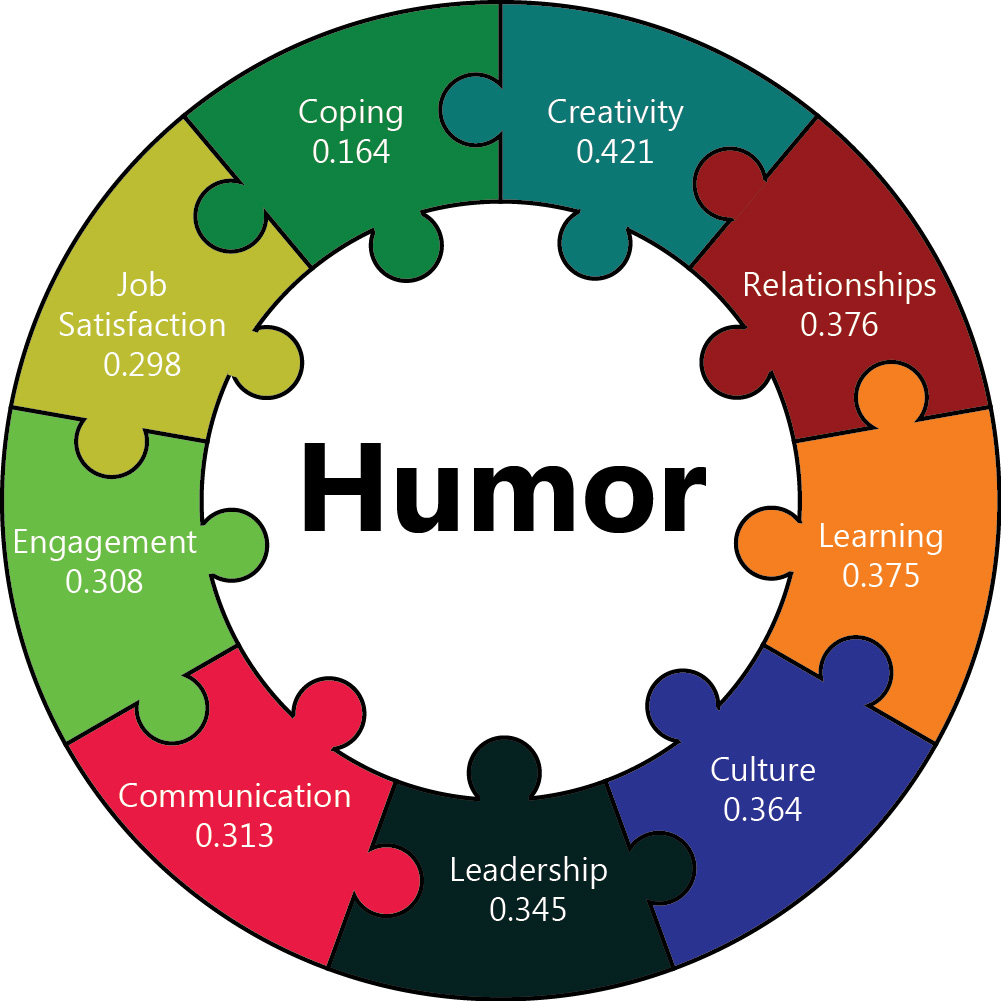Transforming Learning: Don’t Let School Interfere with your Laughing
While many individuals have researched the effect of humor previously, Jonas utilizes a meta-analysis and a meta synthesis. His conclusions not only provide examples of how humor can transform learning, but he also answer the question of “how much”. In other words, this research helps teachers and administrators decide where they can get the most bang for their buck by estimating how much of an effect humor has specific areas.
The following figure lists each of the nine areas where humor has a positive effect. The numbers in each piece of the puzzle denote the statistically significant correlations with humor. For example, humor and creativity have the highest relationship with a .421 correlation and an effect size of .850, which means that if you use humor you can enhance creativity from the 50th percentile to the 80th percentile. Taking this one step further, if you use humor when teaching, the correlation is .377 with effect size of .777. In layman’s terms this means that when you use humor when teaching, there could be as high as a 28% percentile gain—just by connecting to humor.

The new book by Jonas is entitled Transforming Learning: Don’t Let School Interfere with Your Learning (2019) and it recently won national recognition as a finalist in the 2019 “Best Book” Awards. Part of the problem is that humor is not taken seriously by educators, researchers, or the public. Yet, humor has universal appeal and has been an important element of every civilization from the beginning of time to the present. It is appreciated by everyone and is not confined by language, ethnicity, age, time, or place. Despite its worldwide presence, humor does not seem to be taken seriously by leaders or organizations. This is puzzling given the plethora of empirical evidence demonstrating its significant implications for individuals and organizations.
Part of the problem rests with the fact that children laugh more than ten times adults every day. This is not because children have fewer significant problems but rather because society teaches individuals growing up to pay attention, school is to be taken seriously, and there is no place for laughing at work. However, empirical research says just the opposite.
If you laugh at work, there is greater job satisfaction and the turnover of employees decreases by 10%. The University of Chicago completed a longitudinal study and found that people who carry a sense of humor and laugh all the time can live up to eight years longer than the control group. And individuals can see a 27 percentile gain in their leadership when they use humor on a regular basis.
Humor is not only useful in education. Accountemps conducted a survey and found that over 98% of the respondents in business believe that humor is “somewhat important” to “very important” for developing a positive culture with the organization. In 2017, Robert Half International came to a similar conclusion from its survey which showed more than 90% of the executives said that a sense of humor is important for career advancement and 84% said that people with a great sense of humor are more successful leaders.
Ericsson’s research has led him to study expert spellers, elite athletes, and memory champions — and he attributes their diverse successes to deliberate practice, making mistakes, learning from them, and then improving (Ericsson, Anders, & Pool, Robert 2016). Learning to use humor properly takes the same type of practice. Of course, they say that practice makes perfect.
You can certainly memorize funny stories or learn how to tell a joke but know what your strengths and weaknesses are when planning the use of humor. Don’t force humor, you need to be authentic and honest or the audience will be turned off. The next time you are in a meeting think of all the witticisms that would fit the conversation. Do not say them out loud, just write them down and then tell them to your friends to see if they work. Also, think about having a humor board at work, where people can post cartoons or jokes. Or start a meeting by pairing up the participants to have them tell the funniest thing that happened to them over the weekend or have a “pun day” where people try use puns throughout the discussion.
The beauty is that humor is a natural tool. Everyone has a sense of humor (some much more than others). Research is conclusive that humor is a multiplier for positive Learning, Reducing Stress, increasing Job Satisfaction, building Relationships, enhancing Creativity, building Culture, improving Communication, and Engaging participants. What this means is that humor needs to be taken seriously, because when you get people laughing you can transform learning.

